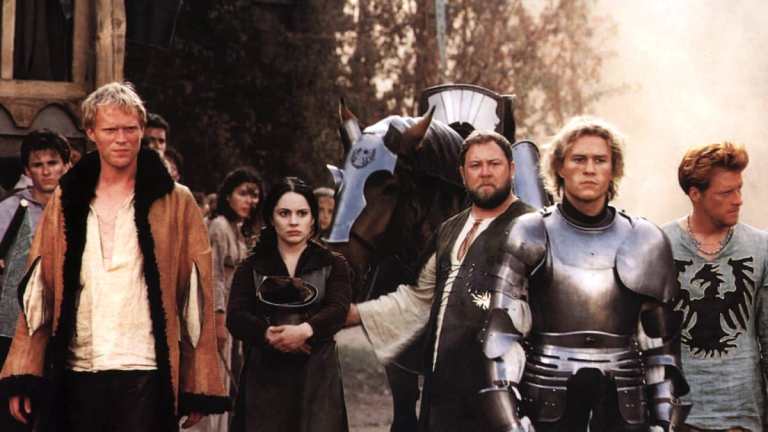The Chaotic Queer Joy of A Knight’s Tale
Upon rewatch, the medieval sports film about “changing your stars,” A Knight’s Tale, is incredibly queer.

Aside from being a rollicking, romantic romp, The Mummy (1999) has carved out an iconic place among movie lovers for what Tor.com’s Leah Schnelbach describes as its chaotic bisexual energy. Here is a movie with an ensemble cast whose combined hotness, sheer charisma, and bucking of gender and societal norms make it so that anyone can see themselves in a variety of characters—and perhaps make some breakthroughs in realizing who they’re attracted to.
As Maggie Tokuda-Hall summed up, “Hot people being horny on main; campy violence; himbos.” But while The Mummy is a unique modern classic, it’s not the only one to spark a bisexual awakening among fans: May I present its equally chaotic bisexual contemporary, Brian Helgeland’s delightful 2001 film, A Knight’s Tale.
Layering medieval anachronism over the familiar beats of a sports narrative, only with jousting replacing football or baseball, A Knight’s Tale succeeds as both an underdog story and a postmodern pastiche. But what really charmed audiences, just like in The Mummy, was its winning ensemble where every single character is captivating: A thatcher’s son (Heath Ledger), boyishly charming, who recklessly dons the identity of a noble with the same confidence he uses while carrying a lance; his beloved, a feminist noblewoman (Shannyn Sossamon) whose beauty belies her wry sarcasm and frustration with her limitations; her lady-in-waiting (Bérénice Bejo), soft-voiced yet takes no bullshit; a frequently naked poet-turned-hype-man (Paul Bettany); a widowed blacksmith (Laura Fraser) who takes on her husband’s trade and then elevates it; two squires, one a soft boy (Mark Addy) and one whose love language is physical touch (Alan Tudyk); and a smoldering noble-blooded villain (Rufus Sewell) who clearly is repressing more than just class outrage at watching this commoner trying to level the playing field.
While the constant refrain of Ledger’s William is that a man can “change his stars”—i.e., the stars under which he was born, primarily meaning social class—this mantra takes on a meta dimension with the movie’s clever subversions of gendered genre archetypes. Then upon further rewatch, there’s the queer and trans lens: changing one’s stars is also the journey toward living as one’s true self.
What makes our medieval misfits so endearing is that they are all committed to faking it til they make it, social mores be damned. Just because their rigid society won’t recognize them as knights or blacksmiths or what-have-yous doesn’t mean that they don’t deserve to be so; if the titles won’t be given, then they’ll be taken. But it’s not until they team up under Sir Ulrich von Liechtenstein’s (fake) banner that each of them is empowered to change their own fates. They also all fall in love with each other a little bit, which makes it that much easier for all of us to fall in love with them.
It’s Geoffrey Chaucer (Bettany) who fabricates the patents of nobility that bring Sir Ulrich into existence, polishing William’s raw jousting talent with a layer of legitimacy. Roland (Addy) and Wat (Tudyk), William’s fellow squires under their late master Sir Ector, agree to act as his subordinates, though they frequently and affectionately knock him down a peg to stay humble. Clothes make the man, and as Sir Ulrich, William must inhibit two spheres: the jousting field and the ballroom. The film flips expectations of who will make which clothes by having blacksmith Kate (Fraser) create innovative new armor—deceptively thin but able to take a lance without denting—and Roland being the fast-thinking seamster who transforms their tent into William’s dashing outfit for the ball.
Yet Kate still balances male and female aspects more than any other character. For a 20th anniversary retrospective with Variety, Helgeland cited research into blacksmiths’ guilds, which decreed that a widow could take over her late husband’s trade, but only for practical objects like horseshoes, which is how we initially meet Kate. Updating William’s armor is an unprecedented challenge for her, but her commitment to something sleek and light makes it triumph over bulkier designs from male blacksmiths. But Kate’s feminine touch goes beyond the smithy; she’s the one who possesses the hidden knowledge of how to dance from her former life as someone’s wife and dance partner. She teaches the boys how to do a farandole so that William can continue his subterfuge. (Later when Kate comments on William and Jocelyn’s puppy love with the tenderness of someone who has loved and lost, a baffled Roland scoffs, “Are you a woman or a blacksmith?” She smiles. “Sometimes I’m both.”)
And can we just say that the choice of David Bowie’s “Golden Years” for the unforgettable dance scene is argument enough for the queerness of this movie.
But the pivotal queer scene is when William’s teammates collaboratively compose a love letter to Jocelyn after he and she have their fight about “better a silly girl with a flower than a silly boy with a stick.” In the same way that William and his friends created the identity of Sir Ulrich, his posse channels his feelings into words that Jocelyn will appreciate. Each shares an insight into what has broken their heart, which Helgeland said was by design: “They’re all broken-hearted except for Heath, who is in love,” he told Variety. “And they’re all in love with Heath in a way.”
How can they not be? Through William, they are finding the confidence to live more authentically. As they speak, and Geoff takes down their words with all the flourishes of his pen, gender falls away; the sentiments they express, though specific to their lives, can not be traced back from men to women or vice versa. The pieces of my broken heart are so small that they can be passed through the eye of a needle. I miss you like the sun misses the flower. It’s love, and grief, and most especially hope, and it’s all universal.
Jocelyn’s response is similarly genderless and expansive: She sends Wat back to deliver a kiss to William. Though the moment is played for comedy, it’s a gentle laugh and more of a character moment for Wat, who is used to expressing himself through violent threats to “fong” people (to grab or kick, though it comes across more suggestive than that) and instead has been asked to sublimate that penchant for physicality into a romantic gesture. (Upon rewatch, I think Jocelyn knew that Wat wasthe perfect go-between to carry her token of affection.)
Rewatching the film, it’s fascinating to see the places in which William’s ascension to knighthood maps onto a trans narrative—and where it does not, as he experiences reversals along the way as his goals shift from triumphing as a false noble to winning as himself. Having Chaucer draw up his patents of nobility initially brings to mind a nonbinary or trans person changing their personal identification (drivers’ licenses, passports, even birth certificates) to the names and pronouns that they identify with, which more often than not do not match what they were assigned at birth.
But despite William taking on the moniker of Sir Ulrich, that name is a means to an end, a way into the tournament but not who William actually sees himself as. It’s the name and title that society expects from him, so he goes along with it in order to survive. Tellingly, when Jocelyn comes to his tent, he shares his real name with her before they become intimate. And when he returns to London for the first time in 12 years for the world championships, William cannot compete until he has revisited the home of his father, John Thatcher, in the commoners’ neighborhood of Cheapside. Though he initially introduces himself to the blind man as Sir Ulrich, he uses the code words “he changed his stars” and “he followed his feet [home]” to reveal himself.
There’s also a wonderful, brief moment with a little girl who declares herself Sir Ulrich’s biggest fan. “When we joust,” she says, referring to playing with the boys, “I always say I’m you!” When William returned to London and saw a blond boy waving at him from the stands, he initially imagined his younger self cheering on the joust a lifetime ago. But this little girl is the real deal; someone who has been so inspired by Ulrich’s success (even before she knows that he shares her humble origins) that she dares to dream that she might someday compete.
Unfortunately, William’s visit to Cheapside also gives his nemesis Count Adhemar (Sewell) the necessary ammunition to reveal him as a pretender. William’s decision not to run is rooted in his innate stubbornness but also his pride at himself; he doesn’t need to hide as Sir Ulrich anymore, even if it means giving up what he most wanted (to defeat Adhemar).
Their showdown in the jail is one of the most sexually charged moments in the movie, arguably just as much as William and Jocelyn in the tent. Adhemar gives William his quintessential speech of “you have been weighed; you have been measured; and you have been found wanting;” yet it is Adhemar who leaves the encounter looking more rattled in the face of William’s conviction even while imprisoned.
Ultimately, it’s Prince Edward (James Purefoy) who intervenes just in time for William to have his showdown against Adhemar, but not as Sir Ulrich. Edward dubs him “Sir William,” citing his personal historians’ recent discovery of an ancient royal line far back in William’s family tree. It’s clear that the prince is using his royal influence to proclaim something that no one can refute (lest they be charged with treason), but the effect is the same as affirming a trans person’s name and pronouns: It’s someone operating from a position of privilege, recognizing another person’s humanity as the person they truly are. Of course the only reason Edward was inspired to use this privilege was because William was the only jouster to recognize him as an opponent and nothing more. He saw him as he wanted to be seen.
In the final joust, William strips away all of the artifice: the fake Sir Ulrich lineage, Kate’s armor (because he’s been wounded by Adhemar’s tipped lance and can’t breathe with it on), even his own newly minted title of knight. As he charges down the field to face Adhemar, he utters one word: “WIIIIILLLLLIIIIAAAAMMMM!”
It’s arguably the campiest moment in the movie, and one that cemented this “bisexual extravaganza’s” place for fans in the queer movie pantheon alongside The Mummy, yes, but also Pirates of the Caribbean, Mr. and Mrs. Smith, and The Mask of Zorro. (Jeez, that decade between the late 1990s and early 2000s really got us bisexuals.) To this day, theme continue, and every time I watch A Knight’s Tale, I giggle at this over-the-top final declaration, this fabulous battle cry.
Except. Except upon rewatching this time—maybe because I’m now a mom to a William of my own, not necessarily named for this movie, but also not not named for this movie—I realized that he says his name the way his father says it in the childhood flashback, when trying to find his son in the crowd of spectators. Here, William echoes John Thatcher’s voice, calling out his own presence for his father who can’t see him, but making sure he hears and knows exactly where his son is. He’s also affirming his true self, calling out the name he’d never believed that he would be able to proudly own or use like it’s a banner, like it’s a lance, like it’s a trophy.
And he couldn’t have done it without first seeing everyone around him—the squires who are no one’s servants, the blacksmith who can dance, the maiden who’s more than a pretty face, the poet whose own humility inspires emotional nakedness—as they truly are.
